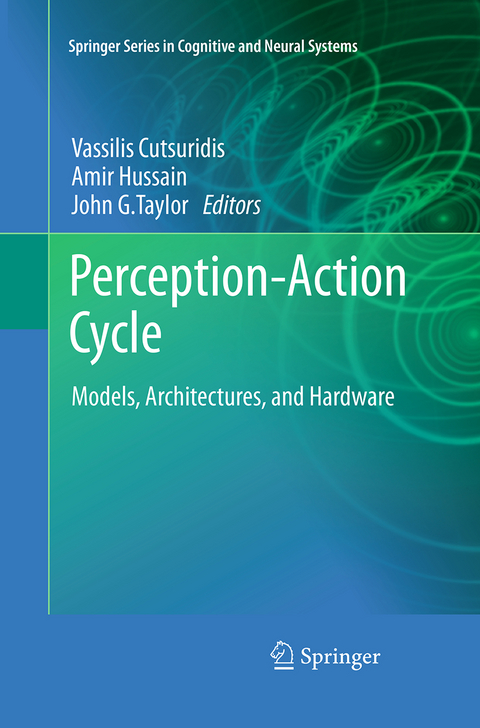
Perception-Action Cycle
Springer-Verlag New York Inc.
978-1-4939-3979-4 (ISBN)
Preface.- Contents.- Contributors.- Part I. Computational neuroscience models.- Chapter 1. The Role of Attention in Shaping Visual Perceptual Processes John Tsotsos, Albert L. Rothenstein.- Chapter 2. Sensory fusion Mauro Ursino, Elisa Magosso, Cristiano Cuppini.- Chapter 3. Modeling learning and memory consistently from psychology to physiology, Andrew Coward.- Chapter 4. Value maps, drives and emotions Daniel Levine.- Chapter 5. Computational neuroscience models: Error monitoring, conflict resolution and decision making Joshua Brown, William H. Alexander.- Chapter 6. Neural Network Models for Reaching and Dexterous Manipulation in Humans and Anthropomorphic Robotic Systems Rodolphe Gentili, Hyuk Oh, Javier Molina, Jose Contreras-Vidal.- Chapter 7. Schemata learning Jun Tani, Ryunosuke Nishimoto.- Chapter 8. Perception-reason-conceptualization-knowledge representation-reasoning representation-action cycle: The view from the brain John Taylor.- Chapter 9. Consciousness, decision making and neural computation Edmund Rolls.- Chapter 10. A Review of Consciousness Models John G. Taylor.- Part II. Cognitive architectures.- Chapter 11. Vision, attention control and goals creation system, Konstantinos Rapantzikos, Yiannis Avrithis, Stefanos Kolias.- Chapter 12. Semantics extraction from multimedia data: an ontology-based machine learning approach Sergios Petridis, Stavros Perantonis.- Chapter 13. Cognitive algorithms and systems of episodic memory, semantic memory and their learnings Qi Zhang.- Chapter 14. Motivational Processes Within the Perception-Action Cycle Ron Sun, Nick Wilson.- Chapter 15. Error monitoring, conflict resolution and decision making Pedro Lima.- Chapter 16. Developmental Learning of Cooperative Robot Skills: A Hierarchical Multi-Agent Architecture John Karigiannis, Theodoros Rekatsinas, Costas S. Tzafestas.- Chapter 17. Actions & Imagined Actions in Cognitive robots Vishwanathan Mohan, Pietro Morasso, Giorgio Metta, Stathis Kasderidis.- Chapter 18. Cognitive Algorithms and Systems: Reasoning and Knowledge Representation Artur S. d'Avila Garcez, Luis C. Lamb.- Chapter 19. Information theory of decisions and actions Tali Tishby, Daniel Polani.- Chapter 20. Artificial consciousness, Antonio Chella, Riccardo Manzotti.- Part III. Hardware implementations.- Chapter 21. Smart sensor networks Alvin Lim.- Chapter 22. Multisensor Fusion for Low-Power Wireless Microsystems, Alan Murray, Tong Boon Tang.- Chapter 23. Bio-inspired mechatronics and control interfaces. Panagiotis Artemiadis, Kostas Kyriakopoulos.-Subject index.
| Erscheinungsdatum | 15.07.2016 |
|---|---|
| Reihe/Serie | Springer Series in Cognitive and Neural Systems |
| Zusatzinfo | XIV, 784 p. |
| Verlagsort | New York |
| Sprache | englisch |
| Maße | 155 x 235 mm |
| Themenwelt | Informatik ► Software Entwicklung ► User Interfaces (HCI) |
| Mathematik / Informatik ► Informatik ► Theorie / Studium | |
| Medizin / Pharmazie ► Medizinische Fachgebiete ► Neurologie | |
| Medizin / Pharmazie ► Studium | |
| Naturwissenschaften ► Biologie ► Humanbiologie | |
| Naturwissenschaften ► Biologie ► Zoologie | |
| Technik ► Elektrotechnik / Energietechnik | |
| ISBN-10 | 1-4939-3979-3 / 1493939793 |
| ISBN-13 | 978-1-4939-3979-4 / 9781493939794 |
| Zustand | Neuware |
| Haben Sie eine Frage zum Produkt? |
aus dem Bereich


